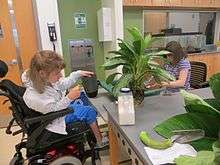Horticultural therapy
Horticultural therapy (also known as social and therapeutic horticulture or STH) is defined by the American Horticultural Therapy Association (AHTA) as the engagement of a person in gardening and plant-based activities, facilitated by a trained therapist, to achieve specific therapeutic treatment goals. The visual aesthetics of plants are known to elicit feelings of inner peace, which generates positive emotions toward a meaningful appreciation of life. Direct contact with plants guides the individual's focus away from stress enhancing their overall quality of life.[1] The AHTA believes that horticultural therapy is an active process which occurs in the context of an established treatment plan.[2] Horticultural therapists are specially educated and trained members of rehabilitation teams (with doctors, psychiatrists, psychologists, occupational therapists and other) who involve the client in all phases of gardening, from propagation to selling products, as a means of bringing about improvement in their life.
History
The usage of horticulture to calm the senses dates as far back as 2000 BC in ancient Mesopotamia, and around 500 BC, ancient Persians created gardens to soothe the senses by involving beauty, fragrance, flowing water, and cool temperatures. [3] According to the American Horticultural Therapy Association, Ancient Egyptian physicians prescribed walks around a garden for patients with mental illness; which makes the first sign of the therapeutic process in Alexandria and Ancient Egypt through Renaissance Europe.[4] During the Middle Ages, on the grounds of a monastery hospital, plants were used to express purpose of cheering up melancholy patients. Also, the gardens were used to treat both physical and mental ailments of sickness who visited them.[5] The first modern documentation of horticulture being used as a treatment for mental health purposes was in the 1800s. Dr. Benjamin Rush discovered that field labor in a farm setting helped attain positive outcomes for clients with mental illness (Simson & Straus, 2003). This discovery lead many hospitals in the western world to begin using horticulture as a means to start therapeutically treating patients with mental health and developmental disabilities. In 1817, the Asylum for Persons Deprived of Their Reason, now known as Friends Hospital, constructed an environment with landscaping, paths and a park atmosphere in effort to assist patients in their recovery. In 1879 Friends Hospital built the first greenhouse that was used for therapy (Simson & Straus, 2003). “During World War I and II, servicemen worked in gardens to improve functioning of injured limbs and increase mental function, but also to learn new skills and to provide food” (http://tiadjones.tripod.com/horttherapy.htm#d). Plants and gardening also came to be used as a diversion for those who were hospitalized long-term.
The 1950s and 1960s brought the first degree in horticultural therapy at Michigan State University. In 1972, Kansas State University created the first curriculum that provided students with dual training in both psychology and horticulture (Simson & Straus, 2003). The first graduate degree program was offered by Clemson University in 1973 (Simson & Straus, 2003). In 1973 the Council for Therapy and Rehabilitation though Horticulture (NCTRH) was established by a group of horticulture therapy professionals. In 1988, they changed their name to the American Horticulture Therapy Association (AHTA) which they are still called today. AHTA is a non-profit organization with about 25% off their members being professionally registered[2]
Credentials
American Horticulture Therapy Association (AHTA) offers the opportunity for professionals interested in practicing horticultural therapy to register as Horticultural Therapists (Horticulture Therapy Registered, HTR). Some colleges and universities have academic programs in horticulture therapy that are accredited through AHTA. AHTA has a set core curriculum for accredited programs to follow. Along with specific classes to take, internships are a very critical component. AHTA requires that to be Horticultural Therapist Registered, 480 hours of field experience are to be completed under supervision of a professionally registered horticultural therapist.

Research
A systematic review examined the effectiveness of horticultural therapy for people with schizophrenia:
| Summary | ||||||||||||||||||||||||||||||||
|---|---|---|---|---|---|---|---|---|---|---|---|---|---|---|---|---|---|---|---|---|---|---|---|---|---|---|---|---|---|---|---|---|
| Based on the current very low quality data, there is insufficient evidence to draw any conclusions on benefits or harms of horticultural therapy for people with schizophrenia. This therapy remains unproven and more and larger randomized trials are needed to increase high quality evidence in this area.[6] | ||||||||||||||||||||||||||||||||
| ||||||||||||||||||||||||||||||||
See also
Notes
- ↑ Lin, Lin, Li (2014). "Planting Hope in Loss and Grief: Self- Care Applications of Horticultural Therapy for Grief Caregivers in Taiwan". Death Studies (38): 603–611.
- 1 2 "American Horticultural Therapy Association Definitions and Positions" (PDF). Archived from the original (PDF) on 2013-09-08.
- ↑ Detweiler, MB; Sharma, T; Detweiler, JG; Murphy, PF; Lane, S; Carman, J; Chudhary, AS; Halling, MH; Kim, KY (2012). "What Is The Evidence To Support the Use of Therapeutic Gardens for the Elderly?". Psychiatry Investig. 9: 100–10. doi:10.4306/pi.2012.9.2.100. PMC 3372556. PMID 22707959.
- ↑ "The Role Application of Horticultural Therapy With Institutionalized Older People" (PDF).
- ↑ "The Role and Application of Horticultural Therapy with Institutionalized Older People" (PDF).
- 1 2 Liu, Y; Bo, L; Sampson, S (2014). "Horticultural therapy for schizophrenia". Cochrane Database of Systematic Reviews. 5: CD009413.pub2. doi:10.1002/14651858.CD009413.pub2.
Bibliography
- Marilyn Barrett Creating Eden, The Garden as a Healing Space (Harper, 1992).
- Francis, Linsay, Rice (Eds.) The Healing Dimensions of People-Plant Relations (Center for Design Research, 1994).
- Haller, Rebecca L. Horticultural Therapy Methods: Connecting People and Plants in Health Care, Human Services, and Therapeutic Programs. CRC Press, Taylor & Francis Group, 2017.
- Norfolk, Donald The Therapeutic Garden (Bantam, 2000).
- Relf, Diane (Ed.) The Role of Horticulture and Human Well-Being (Timber Press, 1992).
- Simson, Sharon & Straus, Martha C. Horticulture as therapy: principles and practice (Routledge, 2003).